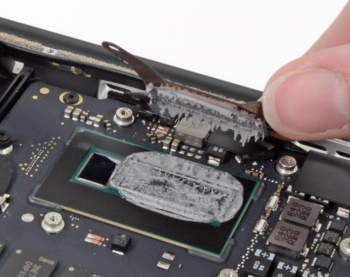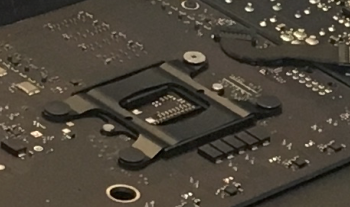Hi there
I've got an A1502 MacBook Pro 13" late 2013 (MBP 11,1; ME867LL/A) which I got secondhand. It's got the 2.8GHz i7 4558U, 16GB RAM and 512GB SSD.
Thing is; it runs hot. All the time. Idle temps fluctuate between 65°C and 99°C most of the times.
I changed out the thermal paste twice: tried MX4 and IC Diamond.
I removed the black adhesive on the CPU under which there was still some old thermal paste left behind.
I cleaned the inside of the machine and the logicboard with a soft toothbrush and isopropyl alcohol when needed. There is no dust or corrosion anywhere, thing looks MINT inside and outside.
Running Mojave 10.14.3 and firmware 149.0.0.0.0.
Nothing particularly alarming regarding OS activity (no spotlight indexing, no updating services, no nothing); an open tab in Firefox and that's it.
Is it just the i7 and poor cooling solution provided by Apple? The CPU throttles itself to death basically.
Thanks in advance!
EDIT: The machine received a new topcase and display by Apple itself.
EDIT: SMC and PRAM have been reset.
I've got an A1502 MacBook Pro 13" late 2013 (MBP 11,1; ME867LL/A) which I got secondhand. It's got the 2.8GHz i7 4558U, 16GB RAM and 512GB SSD.
Thing is; it runs hot. All the time. Idle temps fluctuate between 65°C and 99°C most of the times.
I changed out the thermal paste twice: tried MX4 and IC Diamond.
I removed the black adhesive on the CPU under which there was still some old thermal paste left behind.
I cleaned the inside of the machine and the logicboard with a soft toothbrush and isopropyl alcohol when needed. There is no dust or corrosion anywhere, thing looks MINT inside and outside.
Running Mojave 10.14.3 and firmware 149.0.0.0.0.
Nothing particularly alarming regarding OS activity (no spotlight indexing, no updating services, no nothing); an open tab in Firefox and that's it.
Is it just the i7 and poor cooling solution provided by Apple? The CPU throttles itself to death basically.
Thanks in advance!
EDIT: The machine received a new topcase and display by Apple itself.
EDIT: SMC and PRAM have been reset.
Last edited:






